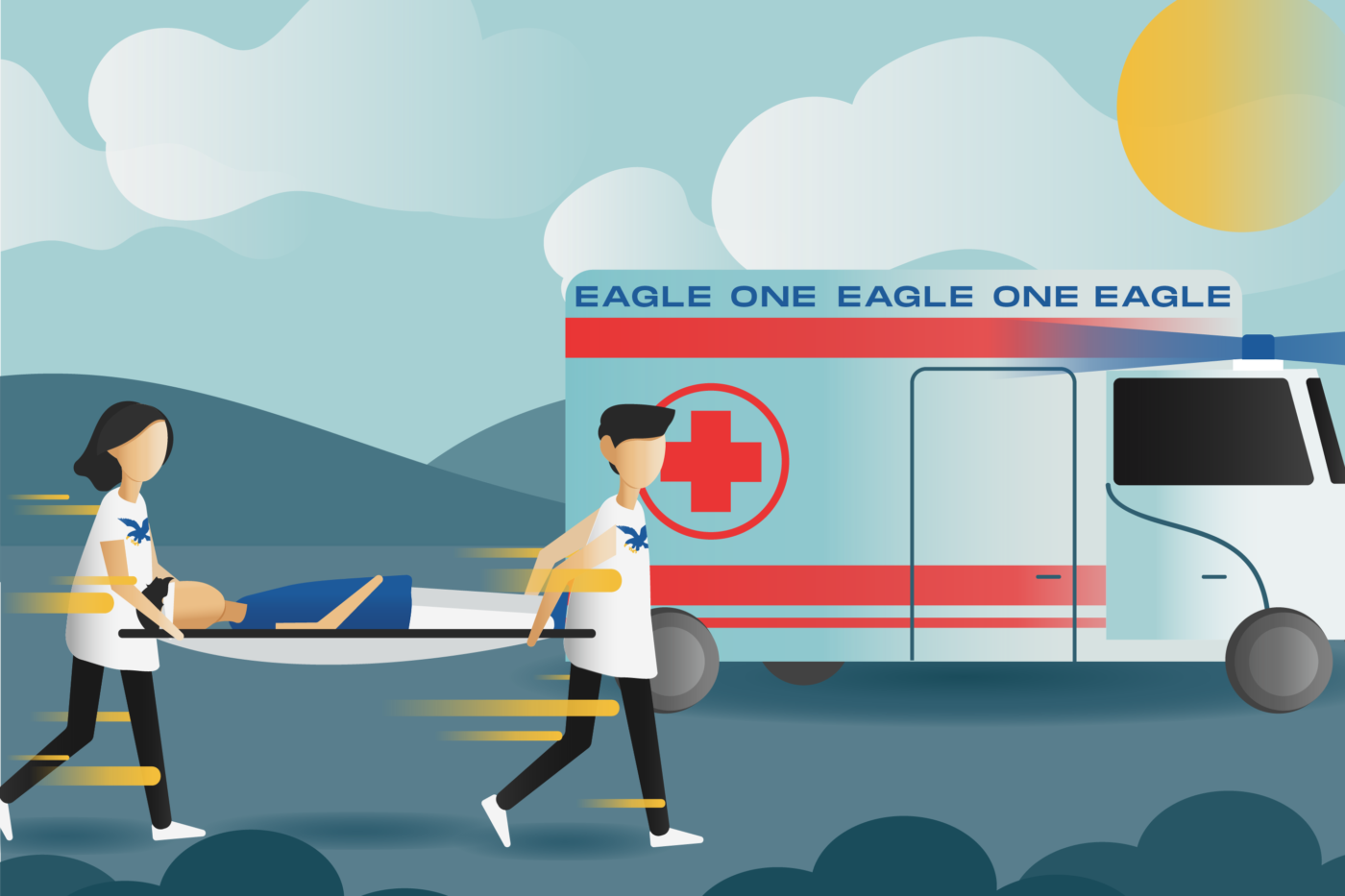BROKEN ANKLES and faint spells can happen anywhere, at any time. A student can easily trip while sprinting from CTC to Bellarmine, or perhaps experience chest pains from drinking too much Kopiko 78 during finals week. However, the Atenean community can find comfort in the sight of a familiar blue ambulance by Schmitt Hall, manned by their campus-roaming heroes garbed in the same hue. These Emergency Medical Technicians (EMTs) are employed by the University’s Megaforce security agency to be among the first responders in the case of medical emergencies on campus.
Between providing first aid care to both physically injured students and individuals suffering from mental health emergencies, to supervising the safety of the community during natural calamities, the EMTs of the unified Ateneo Risk Management Unit (ARMU) serve the University community through invaluable logistical and medical support.
Despite the importance of their job, the EMTs of ARMU face consistent problems with manpower, equipment, and career instability, among others.
Constant vigilance
The University’s EMTs are supervised by the Campus Safety and Mobility Office (CSMO). CSMO Director Marceline Mendoza notes that in addition to daily medical emergencies, the team is tasked with managing the entire University’s disaster response and community welfare in times of natural calamities and campus-wide threats.
According to ARMU team leader Niño Rastrullo, the University’s emergency medical response unit is composed of a team of 14 EMTs, 10 of whom are assigned to mobile duty aboard the campus’ two active ambulance units, aptly named Rescue Eagles One and Two. The remaining ARMU personnel serve as roaming medics throughout Ateneo’s different units in the Loyola Schools, High School, and Grade School.
In addition to stringent hours and stationed duties, the service of ARMU personnel knows no curfew. 12 EMTs are deployed during regular campus hours in coordination with the reserve of five ARMU personnel who are stationed on campus the night prior, forming the unit’s dynamic 24/7 emergency coverage on campus.
Despite its small reserve of medical personnel stationed to respond to the community’s daily emergencies, ARMU continues to ensure the safety of thousands on campus through their storied sense of duty and patience. Despite long working hours and constant exposure to health hazards, the EMTs of ARMU merit full support and appreciation from the University’s administration and the community at large for the value of their work and dedication.
Trained to save lives
In order to become a registered EMT, aspirants must first receive accredited training from any medical institution authorized by the Philippines’ Technical Education and Skills Development Authority (TESDA) with a Certificate of Program Registration (COPR). Once enrolled in the training course, EMT trainees learn the processes involved in life support and study the critical practices involved in emergency medical situations, such as applying basic first aid and monitoring the spread of bodily infections. Upon completion of the average 960 hours of field training and lecture course requirements, graduates of these emergency medical courses are legally certified with a National Certificate II from TESDA, as per the mandate of the Philippine government.
Following government certification and prior to applying for a job in emergency medical services, novice EMTs must prepare for a licensure exam as part of the application process to the Philippine Society of Emergency Medical Technicians (PSEMT). PSEMT grants its members access to mentorship and medical seminar networks. Aside from their studies, training, and networking endeavors, EMTs must also prepare for the typical screening processes and employer-employee interviews when they choose to apply for a job.
Within the context of the University, Loyola Schools Health Services (LSHS) Director Henrietta dela Cruz, MD, notes that EMTs employed by the University receive additional training from the Loyola Schools Health Services on campus protocols, which includes emergency situation psychological training from the Loyola Schools Office of Guidance Counselling (LSOGC).
To the rescue
Rastrullo shares that based on his experience, one of the first skills an EMT develops while on the job is the urgent rush to accurately make initial medical assessments in emergency situations. Injuries may vary from sprained limbs to seasonal illnesses, therefore Rastrullo notes that EMTs must be prepared for changing circumstances and degrees of emergency severity. Following primary assessments, EMTs decide whether or not the patients need secondary care from a permanent medical facility, such as nearby hospitals or ARMU’s own base of operations at the University’s own LSHS clinic.
Once patients who need further emergency care are brought to the main office of the LSHS at the Social Sciences building, the attending physicians assess if the clinic is able to accomodate the patient’s immediate needs. If the physician on duty decides that a student needs tertiary or more specialized care, the student’s parents will be notified of the situation and ARMU transports the patient to the LSHS’ referral hospital at The Medical City in Ortigas, unless the parents or the patient choose to be brought to their own personal physicians.
Rastrullo described an instance in which a student suffered a severe heart attack within the school premises. “Pag dating namin sa kanya, he was clutching his chest, sumisigaw siya sa sakit (When we arrived, he was clutching his chest and shouting in pain).” Rastrullo says that the response of ARMU to the emergency at the time was a success, as the team was able to transport the patient to the hospital in time.
According to dela Cruz, ARMU is also equipped to attend to the needs of patients who experience psychological emergencies with physical manifestations such as hyperventilating and fainting. In such cases, ARMU works with the LSHS in coordinating their response efforts with the support of the LSOGC.
The proper tools
Despite the rigorous training and tests EMTs undergo, their serviceability as a unit is under duress with the plethora of challenges they continue to face. Rastrullo notes that the team is limited by an evident lack of equipment, specifically with defibrillator units. “Actually ang Rescue Eagle One lang ang meron lang defib unit (Actually, Rescue Eagle One is the only ambulance equipped with the defibrillator unit),” says Rastrullo, who explains that they have to leave their only defibrillator unit with the security guards whenever they transport a patient off-campus.
“Yun ang pinaka-importante naming gamit as EMT tiyaka life-saving device talaga yun sa mga cardiac arrest patient (It’s the most important tool we, as EMTs use – it’s a life-saving device especially for people experiencing cardiac arrest), he explains.
However, Mendoza says that more defibrillator units are already scheduled for delivery to the Office of the Vice President for Administration and Human Resources (OVPAHR) by sometime this year.
On the job
According to Rastrullo’s accounts, most EMTs who have worked within the University for Megaforce in the past stay for two years on average to earn a Certificate of Employment and the necessary experience for more profitable work abroad. “Mas makakaganda kung magtatagal yung mga EMT dito kase nagaabroad sila para lang gawin itong training ground para makakuha ng certificate of employment dahil nga kase sa security of tenure dahil outsource nga kami,” he explains.
(It would be better if EMTs stayed for much longer. Most of them go abroad and use this job as a training ground to get a certificate of employment due to the lack of job security since we are outsourced workers).
While Rastrullo maintains that the University’s EMTs are satisfied to be given a sufficient salary and proper work benefits such as Philhealth cards, it would still be preferable to be granted tenureship. In the meantime, the team continues to do their jobs to the best of their abilities.
Rastrullo assesses that the ARMU team is doing “satisfactorily well” in terms of responding to medical emergencies within campus. The team could effectively respond more with additional EMTs, but he stresses that Megaforce has a no work-no pay policy. “Pero ang nakakasad talaga dito sa Megaforce is no work no pay. Kaya pagkamarami kame, maliit lang din salary namin (But it’s sad that Megaforce has a no work-no pay policy. That’s why if we’re a lot, we don’t get paid as much),” says Rastrullo, further explaining the lack of job security EMTs have with their employers.
Despite what extraordinary and persistent challenges EMTs might face in their line of work, these medical responders are stationed 24/7 around campus, ready to put in the arduous work for the populous community they serve in case of any emergency. Their dedication to their work and service ensures that the Loyola Schools is a safer place for all.







